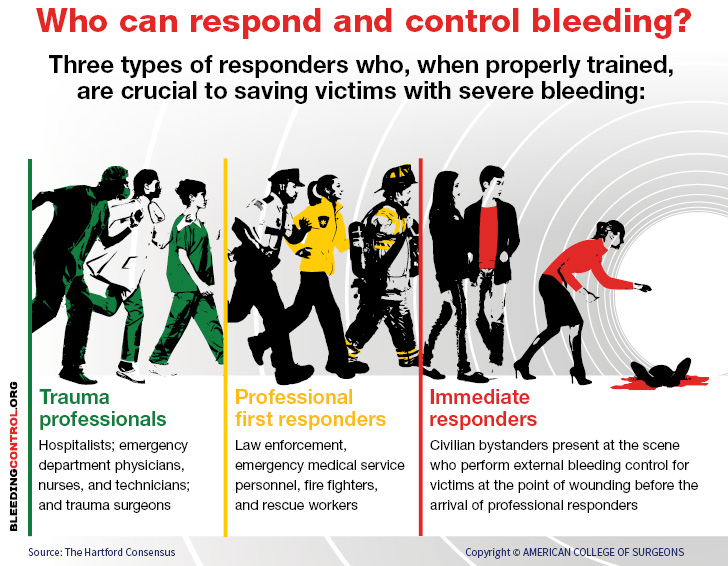Stop the Bleed

The Stop the Bleed course is motivated by the 2012 tragedy in Sandy Hook and multiple tragedies that have occurred in the ensuing years. The resulting injuries from these events generally present with severe bleeding which, if left unattended, can result in death. The participants of the Hartford Consensus concluded that by providing first responders (law enforcement) and civilian bystanders the skills and basic tools to stop uncontrolled bleeding in an emergency situation, lives would be saved.
The University of South Alabama currently does not have any upcoming sessions.
What is Stop the Bleed?
A person who is bleeding can die from blood loss within five minutes. While emergency responders will arrive as quickly as possible, bystanders are almost always there first. In the case of disaster and high-casualty incidents, emergency services are often spread thin. This is where Stop the Bleed comes in to play. This free training program will teach you to stop severe bleeding and save a life! Will you be ready?
Blood loss is the leading cause of preventable death in multiple casualty events, like mass shootings, terrorist attacks and earthquakes. Significant external bleeding can also result from everyday events such as a motorcycle crash or an industrial accident. Rapid control of bleeding at the scene of the event can be life-saving.
That’s why we’re teaming up with the American College of Surgeons, FEMA, and the U.S. Department of Homeland Security to ensure that: Bystanders have skills and knowledge to provide immediate bleeding control to victims at the scene of an event.
Who needs to be trained?
The general public needs to learn bleeding control techniques.
Many civilians have expressed interest in taking a bleeding control training course that would empower them to immediately assist victims of active shooter and other intentional mass casualty events, according to results of a new national poll published in the Journal of the American College of Surgeons.
Furthermore, the vast majority of civilians support training and equipping police officers to perform severe bleeding control on victims as soon as possible, rather than wait for emergency medical services (EMS) personnel to arrive on the scene. There’s also strong public support for putting bleeding control kits in public places where large crowds gather, similar to the way that automatic external defibrillators are now found in airports and shopping malls for use by responders who have undergone CPR/AED training.
Why Stop the Bleed?
Today we live in a world where terrorism, the actions of unstable people, and the dangerous impulses of friends and relatives are very real and becoming increasingly more frequent.
Massive bleeding from any cause, but particularly from an active shooter or explosive event where a response is delayed, can quickly result in death. Similar to how the general public learns and performs CPR, the public must learn proper bleeding control techniques, including how to use their hands, bandages, and tourniquets. Victims can quickly die from uncontrolled bleeding, within five to 10 minutes or less.
Civilians need basic training in bleeding control principles so they are able to provide immediate front line aid until first responders are able to take over care of an injured person. Due to many situations, there may be a delay between the time of injury and the time a first responder is on the scene. Without civilian intervention in these circumstances, preventable death will occur.
Anyone at the scene of an emergency can act as an immediate responder and save lives if they know what to do!
Objective
Our shared goal is to provide the general public with a one-stop, online resource to credible information on how to properly control severe bleeding. We hope you will never have the need to use this information, but if you do, at least you will have the assurance that the information is credible and timely, and you will hopefully have taken a Stop the Bleed training class and be able to administer aid in an emergency.

Contact Information
For more information, please contact:
Shana Noland
smclendon@health.southalabama.edu
(251) 445-9061
Rebecca Scarbrough
rscarbrough@health.southalabama.edu
(251) 471-7971


